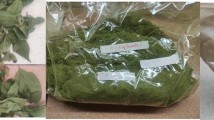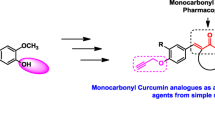Abstract
In this work, a series of lactone 1,4-dihydroquinoline derivatives 4 were efficiently synthesized and characterized by 1H and 13C NMR. The synthesized compounds were evaluated for their in vitro antibacterial activity against the bacterial strains Porphyromonas gingivalis, Prevotella nigrescens, Streptococcus mitis, and Streptococcus sanguinis and against Mycobacterium tuberculosis, Mycobacterium avium and Mycobacterium kansasii. The results revealed that the evaluated compounds were more active against Gram negative bacteria. Compounds 4ba, 4bb, 4bg, 4bi, 4bn, 4ch, and 4ci displayed moderate antibacterial activity against P. gingivalis. 4bi was the most active compound against the three strains of Mycobacterium. Based on structure–activity relationship studies, we observed that the presence of a nitro group on the benzylic ring and a methylenedioxy group on the dihydroquinoline ring enhanced the antibacterial activity of the derivatives.



Similar content being viewed by others
References
Antunez-Mojica M, Rodríguez-Salarichs J, Redondo-Horcajo M, Leon A, Barasoain I, Canales A, Cañada FJ, Jiménez-Barbero J, Alvarez L, Díaz JF (2016) Structural and biochemical characterization of the interaction of tubulin with potent natural analogues of podophyllotoxin. J Nat Prod 79(8):2113–2121
Desai NC, Patel By, Dave BP (2017) Synthesis and antimicrobial activity of novel quinoline derivatives bearing pyrazoline and pyridine analogues. Med Chem Res 26(1):109–119
El-Essawy AF, El-Sayed WA (2013) Synthesis of new 1,3,4-Oxadiazol, Thiadiazole, 1,2,4-Triazole, and Arylidene Hydrazide derivatives of 4-Oxo-1,4-dihydroquinoline with antimicrobial evaluation. J Heterocycl Chem 50(S1):E1–E8
Frackenpohl J, Adelt I, Antonicek H, Arnold C, Behrmann P, Blaha N, Böhmer J, Gutbrod O, Hanke R, Hohmann S, Houtdreve M, Lösel P, Malsam O, Melchers M, Neufert V, Peschel E, Reckmann U, Schenke T, Thiesen HP, Velten R, Vogelsang K, Weiss HC (2009) Insecticidal heterolignans—Tubuline polymerization inhibitors with activity against chewing pests. Bioorg Med Chem 17:4160–4184
Grabarczyk M, Mączka W, Wińska K, Żarowska B, Aniol M (2013) Antimicrobial activity of hydroxylactone obtained by biotransformation of bromo-and iodolactone with gem-dimethylcyclohexane ring. J Braz Chem Soc 24(12):1913–1919
Kharb R, Kaur H (2013) Therapeutic significance of quinoline derivatives as antimicrobial agents. Int Res J Pharm 4(3):63–69
Keri R, Patil AS (2014) Quinoline: a promising antitubercular target. Biomed Pharmacother 68(8):1161–1175
Mazur M, Bania J, Nawrot J, Klejdysz T, Wawrzeńczyk C (2016) Lactones 46. Synthesis, antifeedant and antibacterial activity of γ-lactones with a p-methoxyphenyl substituent. Pest Manag Sci 72(3):489–496
Meléndez-Gómez CM, Kouznetsov VV (2013) Recent developments on antimicrobial quinoline chemistry. In: Méndez-Vilas A (Ed.) Microbial Pathogens And Strategies For Combating Them: Science, Technology And Education (Volume 1). Formatex Research Center, Columbia, p 666–677
Palomino JC, Martin A, Camacho M, Guerra H, Swings J, Portaels F (2002) Resazurin microtiter assay plate simple and inexpensive method for detection of drug resistance in Mycobacterium Tuberculosis. Antimicrob Agents Chemother 46:2720–2722
Qiu H, Qian S, Head SA, Liu JO, Jin Z (2016) Insights into the structure-activity relationship of the anticancer compound ZJ-101, a derivative of marine natural product superstolide A: a role played by the lactone moiety. Bioorg Med Chem Lett 6(15):3411–3413
Shahid HA, Jahangir S, Yousuf S, Hanif M, Sherwani SK (2016) Synthesis, crystal structure, structural characterization and in vitro antimicrobial activities of 1-methyl-4-nitro-1H-imidazole. Arab J Chem 9(5):668–675
Spanò V, Parrino B, Carbone A, Montalbano A, Salvador A, Brun P, Vedaldi D, Diana P, Cirrincione G, Barraja P (2015) Pyrazolo[3,4-H]quinolines promising photosensitizing agents in the treatment of cancer. Eur J Med Chem 102:334–351
Teponno RB, Kusari S, Spiteller M (2016) Recent advances in research on lignans and neolignans. NatProdRep 33:1044–1092
Vandekerckhove S, D’hooghe M (2015) Quinoline-based antimalarial hybrid compounds. Bioorg Med Chem 23:5098–5119
Vandekerckhove S, Van Herreweghe S, Willems J, Danneels B, Desmet T, Kock C, Smith PJ, Chibale K, D’hooghe M (2015) Synthesis of functionalized 3-, 5-, 6- and 8-aminoquinolines via intermediate (3-pyrrolin-1-yl)- and (2-oxopyrrolidin-1-yl)quinolines and evaluation of their antiplasmodial and antifungal activity. Eur J Med Chem 92:91–102
Viegas-Junior C, Danuello A, da Silva Bolzani V, Barreiro EJ, Fraga CAM (2007) Molecular hybridization: a useful tool in the design of new drug prototypes. Curr Med Chem 14:1829–1852
Sousa RMF, Morais SAL, Vieira RBK, Napolitano DR, Guzmanb VB, Moraes TS, Cunha LCS, Martins CHG, Chang R, Aquino FJT, Nascimento EA, Oliveira A (2015) Chemical composition, cytotoxic, and antibacterial activity of the essential oil from Eugenia calycina Cambess leaves against oral bacteria. Ind Crops Prod 65:71–78
CLSI (2012a) Methods for Antimicrobial Susceptibility Testing of Anaerobic Bacteria, CLSI Document M11-A8, 8 ed. Clinical and Laboratory Standards Institute, Wayne, PA, p 39
CLSI (2012b) Methods for Dilution Antimicrobial Susceptibility Tests for Bacteria That Grow Aerobically, CLSI Document M7-A9, 9 ed. Clinical and Laboratory Standards Institute, Wayne, PA, p 63
Acknowledgements
The authors would like to thank Fundação de Amparo à Pesquisa do Estado de São Paulo (FAPESP) (Proc. 2014/07493-5), for their financial support and Coordenacão de Aperfeiçoamento de Pessoal de Nível Superior (CAPES) for scholarship.
Author information
Authors and Affiliations
Corresponding author
Ethics declarations
Conflict of interest
The authors declare that they have no conflict of interest.
Electronic supplementary material
Rights and permissions
About this article
Cite this article
Laurentiz, R.S., Gomes, W.P., Pissurno, A.P.R. et al. Synthesis and antibacterial activity of new lactone 1,4-dihydroquinoline derivatives. Med Chem Res 27, 1074–1084 (2018). https://doi.org/10.1007/s00044-017-2129-x
Received:
Accepted:
Published:
Issue Date:
DOI: https://doi.org/10.1007/s00044-017-2129-x




